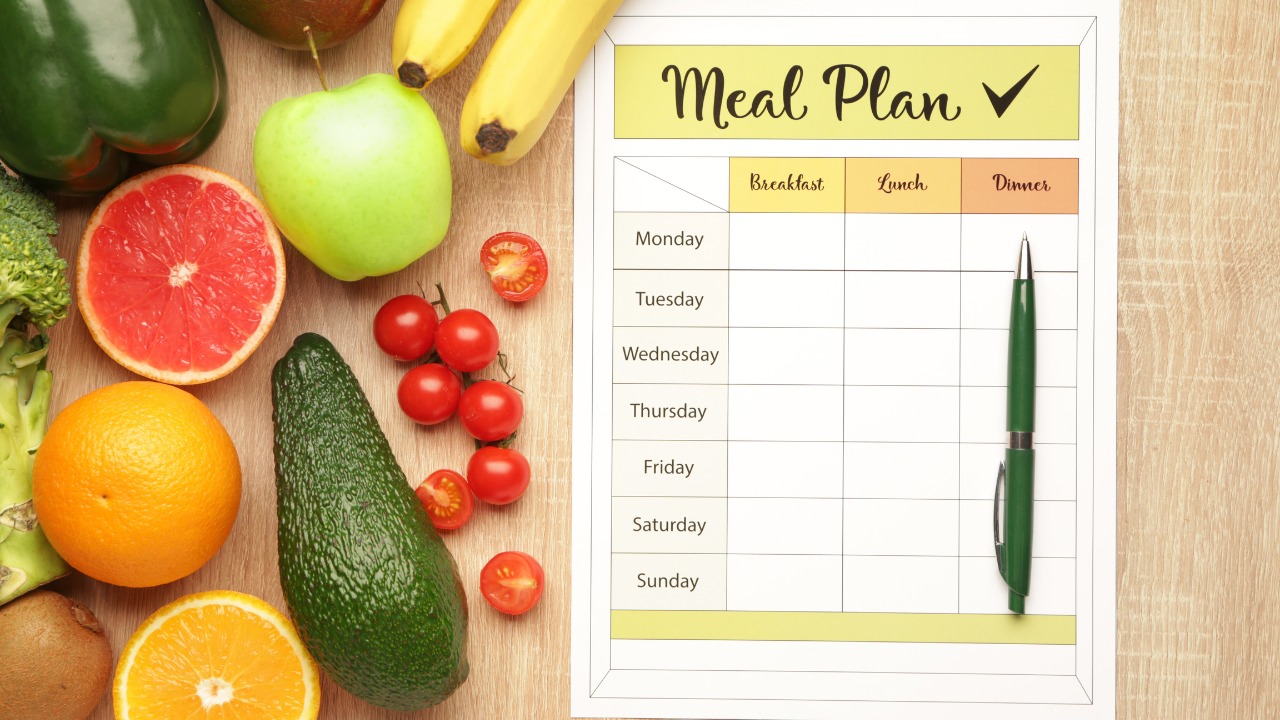Did you know that the average person spends over an hour each day thinking about and preparing meals? That’s more than 365 hours a year! Imagine what you could do with that time if your meals were planned and prepped in advance. I can personally attest to the power of meal planning—I’ve seen firsthand how it can transform dinner time from a source of stress into an opportunity for connection and nourishment.
A well-organized meal planning routine is more than just a strategy for saving time; it’s a pathway to a balanced, stress-free life. When you know what’s on the menu, you’re less likely to reach for unhealthy options, more inclined to enjoy family meals, and far more equipped to stick to a budget. Meal planning ensures that your week runs smoothly, with fewer last-minute scrambles and more time to focus on what matters most.
In this post, I’ll guide you through establishing a meal planning routine that fits seamlessly into your lifestyle. Whether you’re new to meal planning or looking to refine your approach, I’ll share actionable tips and insights to help you make meal planning an indispensable part of your weekly routine.
Why You Need a Meal Planning Routine
A well-established meal planning routine is a game-changer for anyone looking to bring more ease and joy into their daily life. Here’s why you need one:
1. Save Time
One of the most immediate benefits of meal planning is the time you save. By deciding on your meals ahead of time, you eliminate the daily question of “What’s for dinner?” Instead of making multiple trips to the grocery store each week, you can consolidate your shopping into one efficient visit, freeing up more time for yourself and your family.
2. Save Money
Meal planning also has a significant impact on your budget. When you plan your meals, you shop with purpose—only buying what you need and avoiding impulse purchases. This leads to more efficient grocery shopping and less food waste. Plus, having a plan reduces the temptation to order takeout or dine out, saving you money in the long run.
3. Improve Nutrition
With a meal plan in place, you have the opportunity to ensure that your family is eating balanced, nutritious meals. Instead of resorting to convenience foods, you can plan meals that are rich in vegetables, whole grains, and lean proteins. This thoughtful approach to eating supports overall health and well-being, helping everyone in the family feel their best.
4. Reduce Stress
Knowing what’s for dinner each night is a huge stress reliever. There’s no need
to scramble at the last minute or worry about what ingredients you have on hand. With a meal plan, you can approach each evening with confidence and calm, knowing that dinner is taken care of. This reduction in daily stress can improve your overall quality of life.
5. Foster Family Harmony
Meal planning is a great way to bring the family together. By involving everyone in the process, you can ensure that meals accommodate different dietary needs and preferences. This shared responsibility fosters a sense of teamwork and helps to create meals that everyone will enjoy, making mealtime a more harmonious and enjoyable experience for all.
When feeding a family with both vegans and non-vegans, mealtime can often feel like a juggling act. The need to cater to different dietary preferences can lead to stress, frustration, and even burnout, especially when trying to ensure everyone is happy and well-fed. This is where meal planning becomes a game changer. By thoughtfully planning meals in advance, you can create dishes that are easily adaptable, with base components that satisfy everyone and customizable options that cater to individual needs.

Getting Started with Meal Planning
1. Assess Your Needs
The first step in establishing an effective meal planning routine is understanding the unique needs of your family. Take time to assess everyone’s preferences, dietary restrictions, and schedules. This might involve considering who prefers plant-based meals, who needs gluten-free options, or who has a busy evening schedule that requires quick dinners. Understanding these factors will help you craft a meal plan that’s both satisfying and practical. It’s also a great opportunity to involve your family in the process—ask for their input on favorite meals and ingredients they’d like to see on the menu. This way, everyone feels included and you’ll be better equipped to create a plan that meets everyone’s needs.
2. Set Goals
Once you have a clear understanding of your family’s needs, it’s time to set some goals for your meal planning routine. What do you want to achieve? Perhaps you’re aiming for healthier eating habits, incorporating more plant-based meals, or trying to stick to a tighter grocery budget. Maybe your goal is simply to reduce the stress of daily meal decisions or to add more variety to your weekly dinners. Whatever your objectives, having clear goals will guide your meal planning and help you stay focused on what matters most to your family.
3. Gather Tools
To make meal planning a seamless part of your routine, gather the right tools to help you stay organized. Meal planning apps can be incredibly useful, offering features like recipe storage, automated grocery lists, and even scheduling. A simple calendar—whether digital or physical—can help you map out your weekly meals at a glance. Additionally, having a master grocery list template can save time and ensure you’re not missing any essential ingredients. By equipping yourself with these tools, you’ll streamline the process and make meal planning a more efficient and enjoyable task.
Steps to Establish a Meal Planning Routine
Step 1: Choose a Planning Day
One of the most effective ways to maintain a meal planning routine is to pick a consistent day each week to plan your meals. Whether it’s Sunday morning with a cup of coffee or Friday evening before the weekend grocery run, having a dedicated time for meal planning helps to make it a regular part of your routine. Use a planner or digital calendar to jot down your meals for the week, ensuring you have a clear picture of what’s ahead. This consistency not only saves time but also creates a sense of anticipation and organization in your weekly schedule.
If you have a dynamic schedule where you can’t pick a consistent weekly time to plan, make it a recurring task to set the time aside to create a schedule.
Step 2: Inventory Check
Before you dive into planning your meals, take stock of what you already have in your pantry, fridge, and freezer. This step is crucial for reducing food waste and ensuring you’re using up ingredients before they go bad. Make a list of items that need to be used soon, such as those veggies nearing their prime or that half-used jar of sauce. By incorporating these items into your meal plan, you minimize waste and make the most of what you’ve already purchased. This practice also helps keep your grocery budget in check by avoiding unnecessary purchases.
Step 3: Plan Your Meals
Now that you have a clear idea of what you have on hand, it’s time to plan your meals. Consider the week ahead and outline your breakfast, lunch, dinner, and snacks. This is where you can get creative—incorporate family favorites to ensure everyone is satisfied while also introducing new recipes to keep things exciting. For families with diverse dietary needs, this step is particularly important to ensure you have meals that cater to everyone’s preferences. Remember to balance convenience with variety, opting for quick meals on busy nights and more elaborate dishes when you have the time. To ensure you plan meals for the time you have, block out the time in your schedule for dinner prep. By reviewing if you have 10, 20 or 30-minutes on a given night, you can choose a meal that works for you (instead of creating more work). It will also help you determine what meals or components you can prepare ahead of time earlier in the week or on the weekend.
Step 4: Create a Grocery List
Once your meals are planned, it’s time to create a detailed grocery list. A well-thought-out list is your best friend when it comes to efficient shopping. Base your list on the ingredients needed for your planned meals, cross-referencing with what you already have from your inventory check. To make your shopping trip even smoother, organize the list by store sections—produce, pantry items, dairy, etc. This not only saves time but also helps you avoid backtracking in the store. A thorough grocery list ensures that you have everything you need for the week ahead, reducing the chances of midweek trips to the store.
Step 5: Prep in Advance
The final step to establishing a successful meal planning routine is to prep in advance. Taking some time to prepare ingredients or even entire meals ahead of time can save you significant stress during the week. Batch cooking is an excellent strategy—prepare large quantities of staples like grains, roasted vegetables, or proteins, and use them in multiple meals throughout the week. Leftovers can also be creatively repurposed into new dishes, giving you more mileage out of your cooking efforts. Whether it’s chopping veggies for a stir-fry or cooking a big pot of soup, a little prep goes a long way in making your weeknights smoother and more enjoyable.
For more help in creating your routine, check out my personal system here.

Tips for Successful Meal Planning
Involve the Family
Meal planning becomes a more enjoyable and successful process when everyone in the family is involved. Not only does this ensure that everyone’s preferences are considered, but it also turns meal planning into a shared activity rather than a solo chore. Create a Family Favorites list and update it on an ongoing basis so you can pull from it weekly to plug into your meal plan. Gather the family together to discuss the upcoming week’s meals (I do this on Thursday nights during dinner), or let each person pick a favorite dish to include. For families with mixed dietary needs, this is especially important. It ensures that everyone feels included and satisfied, making mealtime a more harmonious and enjoyable experience. Plus, getting the kids involved in choosing or preparing meals can help them develop healthy eating habits and a love for cooking.
Try Themed Nights
To make meal planning easier and more fun, consider introducing themed nights into your routine. Themes like Meatless Mondays, Taco Tuesdays, or Pizza Fridays provide a structure that simplifies decision-making and adds an element of excitement to the week. Themed nights can also be a great way to introduce variety into your meal plan, ensuring you’re not eating the same things over and over. Plus, they can turn dinner into something to look forward to—who doesn’t get excited for Taco Tuesday? Whether you stick to classic themes or create your own, themed nights are a playful yet practical strategy for successful meal planning.
Use templates
Easily capture your family’s favorite meals and take the thinking out of what to plug into your plan each week with a meal plan template. Templates streamline the meal planning process by providing a structured format that makes it easy to organize your meals for the week. Using a template not only saves time but also helps ensure that your meal plan is well-rounded and meets your goals. Plus, having a visual guide can keep you motivated and make the planning process feel less daunting. I have 3 templates that I rotate every week so my family never gets bored with what I’m serving. Taco Tuesday is on the menu every week, but one template for example, includes a Main Dish Salad on Mondays while another one features Bowls.
Overcoming Common Meal Planning Challenges
Busy Schedules
When your family’s schedule is jam-packed with activities, meetings, and commitments, finding time to cook a healthy meal can feel like a daunting task. But with a little planning, even the busiest households can enjoy home-cooked meals. One of the best strategies is to rely on slow cooker or Instant Pot recipes, which allow you to prepare meals with minimal effort. These appliances can be a lifesaver on hectic days, as they enable you to toss ingredients in, set the timer, and walk away. By the time you’re done with your day’s tasks, a delicious, hot meal is ready to serve. Batch cooking on weekends or prepping ingredients ahead of time are other great strategies to ensure you have meals ready to go during the week. With a well-thought-out plan, you can avoid the stress of last-minute cooking and still provide nutritious meals for your family.
Picky Eaters
Dealing with picky eaters can be one of the biggest hurdles in meal planning. The key is to offer customizable meals such as food bars that allow each family member to tailor their plate to their liking. Think of meals like tacos, grain bowls, or build-your-own pizzas—each person can choose their preferred toppings or ingredients, making it easier to satisfy everyone at the table. Another strategy is to involve picky eaters in the meal planning and preparation process. When children or even adults have a say in what’s being cooked, they’re more likely to try new foods and enjoy the meal. You can also introduce new ingredients gradually, mixing them with familiar favorites to ease picky eaters into expanding their palates.
Dietary Restrictions
Meal planning can be particularly challenging when accommodating various dietary restrictions, whether due to allergies, intolerances, or personal choices like veganism. However, with careful planning, it’s possible to create meals that meet everyone’s needs without extra hassle. Start by identifying common ingredients that work for multiple diets, such as grains, vegetables, and plant-based proteins. From there, you can build meals that allow for easy modifications—like offering both a vegan protein and a meat option for a mixed-diet family. Keeping a collection of go-to recipes that are easily adaptable for different dietary needs is also helpful. For example, many dishes can be made gluten-free by swapping out certain ingredients, or dairy-free by using plant-based alternatives. By planning meals that can be customized to suit everyone’s dietary requirements, you ensure that everyone at the table feels included and well-fed, reducing mealtime stress and enhancing family harmony.
Get Started With Your Meal Planning
Meal planning is more than just a strategy to organize your meals—it’s a tool that can save you time, money, and stress while improving your family’s nutrition and fostering togetherness. By taking the time to assess your needs, set clear goals, and follow a structured routine, you can transform mealtime from a daily challenge into a source of joy and satisfaction. Whether you’re dealing with busy schedules, picky eaters, or dietary restrictions, meal planning provides a framework that helps you stay on track and ensures that everyone at the table is well-fed and happy.
Starting your meal planning journey might feel overwhelming at first, but remember that it gets easier with practice. Begin with simple steps and gradually build up your routine as you gain confidence. Flexibility is key—allow yourself to adapt as needed, and don’t be afraid to try new things. The more you plan, the more you’ll see the benefits, and soon, meal planning will become second nature.
I’d love to hear from you! What are your go-to meal planning tips or challenges? Share your experiences in the comments below, and don’t forget to subscribe for more meal planning advice, recipes, and inspiration to help make your mealtimes stress-free and enjoyable.
Additional Meal Planning Resources
Get My Free 1-Week Dinner Plan
Easily plug in meals to your meal plan with the recipes in my free 1-week dinner plan. Click here to get it now.


